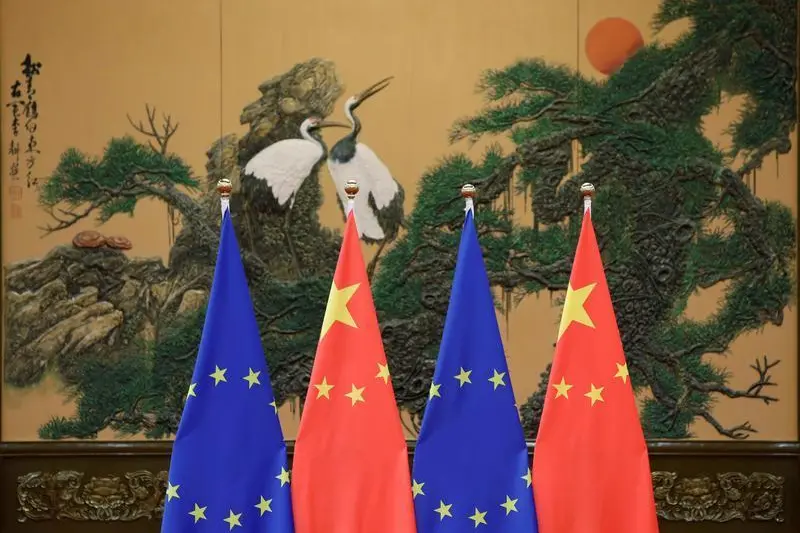PHOTO
BRUSSELS - The European Union's plan to hike tariffs on Chinese electric vehicles (EVs) reflects a firming of its stance towards Beijing, but falls short of a tougher U.S. position tending towards an outright decoupling from China.
In terms of the move itself, the EU's nearly five-fold increase in duties for some Chinese producers exceeds Washington's quadrupling of tariffs on Chinese EV imports, deepening the U.S.-China trade war.
However, U.S. President Joe Biden's plans extend to a range of Chinese products, with the EV rate to be set at 100%. The EU's action is limited to EVs, with a maximum overall tariff of 48.1% and a weighted average of 31%.
The more modest action stems from the EU's strong belief that trade should be based on international rules and its awareness that it has more to lose from a trade war with China.
"The U.S. measures are designed to exclude Chinese EVs. The EU intention is to take away Chinese companies' advantage," said Niclas Poitiers, research fellow at think tank Bruegel. "The EU case is different. It's designed to nullify the subsidy effect."
Beijing called U.S. tariffs a case of "typical bullying", with a slightly milder rebuke that the 27-country EU was engaged in a "typical case of protectionism". It is still unclear quite how China will respond.
TOUGHER EU
Certainly, the EU has intensified its scrutiny of Chinese business over the past 12 months.
The bloc appears to have learned a lesson from an investigation into Chinese solar panels a decade ago, when it did not impose tariffs and the EU's own industry collapsed.
Its anti-subsidy investigation into Chinese EVs is its highest-profile case in years. It is also the first instance of the Commission starting a new case on its own initiative, rather than following up an EU industry's complaint.
The Commission has launched a series of investigations under its Foreign Subsidies Regulation, which is designed to curb foreign companies that operate within the bloc and receive distortive subsidies. China has been the clear focus.
The EU executive has also updated its report on state-led distortions in the Chinese economy. It opens the door to complaints from EU chip or clean-tech producers, adding potential cases to those from traditional sectors such as steel or ceramics. There is no similar report for any other country.
The European Union increasingly views China as a strategic rival. At the end of 2023, its diplomatic service said Beijing was becoming more repressive at home and assertive abroad, resorting to economic coercion or export controls on critical minerals. China's support of Russia after the invasion of Ukraine has heightened concerns.
De-risking, or reducing reliance on China, is now the EU's mantra.
EU: RULE-BOUND, CHINA-BOUND
Aslak Berg, research fellow at the Centre for European Reform, said the European Union was moving towards the U.S. position, but not to the same extent and that it was still using its traditional tools.
"It's more politically sensitive, but it's not legally different from cases of steel tariffs," he said, referring to Wednesday's action on EVs.
The EU case solely concerns subsidies, while in justifying the U.S. measures, Biden also highlighted threats of Chinese technology transfer and cyber espionage.
The EU insists it is committed to rules-based international trade and that its investigation and tariffs are compatible with World Trade Organization rules. The U.S. has said WTO rules fail to address Chinese "non-market" practices.
"The EU is still acting in the same framework as pre-Trump. With China, the U.S. has freed itself from restraints of the WTO and is acting according to domestic policy," Berg said.
The EU's more cautious stance reflects its economic ties to China.
Last year, U.S-China goods trade totalled $573 billion, with U.S. exports of $148 billion. For EU-China, goods trade was 739 billion euros ($798 billion), with EU exports of 223 billion euros ($241 billion).
German car producers, which export some 30% of their models to China, have been most critical of the tariffs.
"For the EU, it is not reasonable to copy what the U.S. is doing," said Poitiers.
CER's Berg said the U.S. and the EU each saw their rivalry with China in different ways. The former wanted to limit a challenge to its global supremacy, while the latter was more concerned with how a larger China behaved.
($1 = 0.9260 euros)
(Editing by Catherine Evans)























